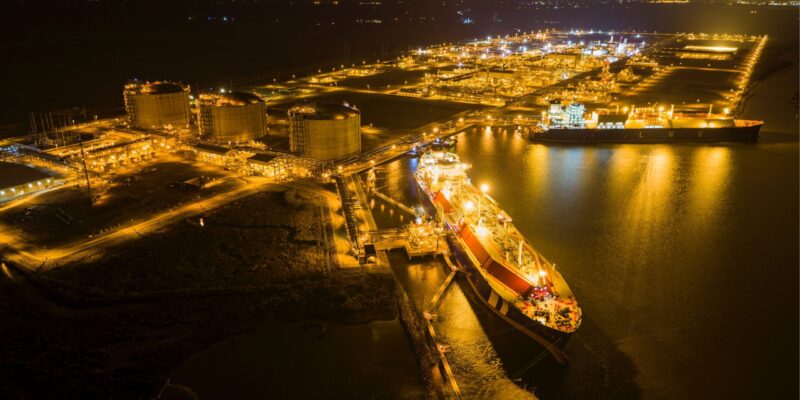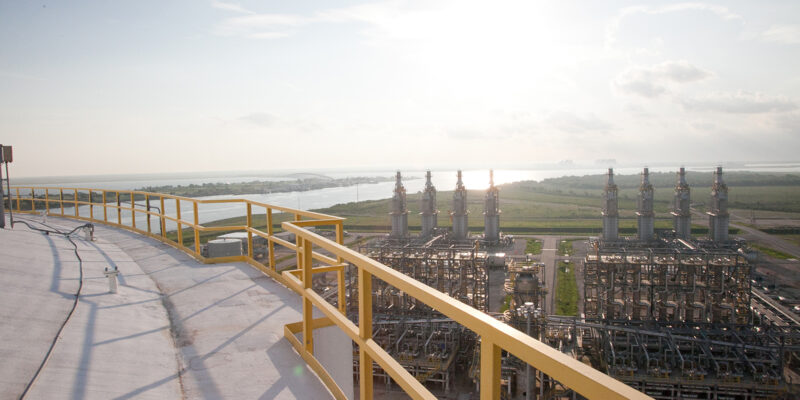A rendering of the Port Arthur LNG liquefaction project in Texas. Image ©SIP
Massive investments in LNG projects are setting up Texas as an energy hub on a global scale. For these projects all types of equipment are needed, from valves over piping materials to flow control measurement devices such as flowmeters, temperature sensors and level transducers.
By Joanne McIntyre & Madeline McNabb
US energy infrastructure company Sempra Infrastructure Partners (SIP) recently announced the start of Phase 1 of the Port Arthur LNG project in Port Arthur, Texas in a joint venture with an affiliate of ConocoPhillips. With the project estimated to cost USD13 billion, it’s yet another example of how the Lone Star State is becoming the energy capital for the US, and maybe the world.
“At Sempra, we believe bold, forward-looking partnerships will be central to solving the world’s energy security and decarbonization challenges,” said Jeffrey W. Martin, chairman and chief executive officer of Sempra. “With strong customers, top-tier equity sponsors in ConocoPhillips and KKR and a world-class contractor in Bechtel, this project has the potential to become one of America’s most significant energy infrastructure investments over time, while creating jobs and spurring continued economic growth across Texas and the Gulf Coast region.”
“Sempra’s selection of Port Arthur as the location for a new natural gas liquefication and export terminal is a strategic decision that will cement Texas’ position as the energy capital of the world,” said Texas Gov. Greg Abbott. “With a highly skilled workforce and business-friendly climate, and as a national leader in LNG exports, Texas is the prime location to expand LNG operations to unleash the United States’ full economic potential in such a critical industry.”
Port Arthur Phase 1
The Port Arthur LNG Phase 1 project is designed to include two natural gas liquefaction trains, two LNG storage tanks and associated facilities with a capacity of approx. 13 million tonnes per annum (Mtpa). Total capital expenditures for the Port Arthur Phase 1 project are estimated at USD13 billion.
“Our strategic LNG partnership with Sempra will help supply growing global demand for natural gas, a lower greenhouse gas emissions-intensity fuel expected to play a critical role in the energy transition and global energy mix going forward,” said Ryan Lance, ConocoPhillips chairman and chief executive officer.
Sempra Infrastructure has contracted with global engineering, construction and project management firm Bechtel Energy Inc. and has issued a final notice to proceed with the project. The expected commercial operation dates for Train 1 and Train 2 are 2027 and 2028, respectively.
“We’re proud to partner with Sempra to deliver a world-class LNG facility. Building from mature, scalable energy technologies helps safeguard our energy supplies and promote the transition to lower-carbon energy,” said Brendan Bechtel, Chairman and CEO of Bechtel. The Phase 1 project is expected to create an estimated 5,000 highly skilled jobs during construction and boost the economies in Port Arthur and Jefferson County.
Accelerating access
Part of Sempra’s mission is to be a leader in North America’s growing liquefied natural gas (LNG) export market, developing the infrastructure to bring cleaner, more reliable and more affordable energy to the world. Sempra’s existing and proposed LNG projects are designed to leverage North America’s abundance of natural gas through LNG exports to reduce its trade deficit, create jobs, meet global energy demand and improve the energy security of its allies.
Sempra’s LNG operations work to provide US producers of natural gas with access to global markets. Sempra Infrastructure owns an interest in Cameron LNG, a 12 million ton per annum (Mtpa) export facility operating in Hackberry, Louisiana, and is currently developing additional LNG export facilities on the Gulf Coast and Pacific Coast of North America through Cameron LNG Phase 2, Port Arthur LNG in Texas and Energía Costa Azul LNG (ECA) in Mexico.

Texas, the LNG hub
Texas is one of the leading states in the United States for natural gas production and liquefaction. It has several LNG liquefaction plants that produce liquefied natural gas for export to other countries and is rapidly becoming known as the energy hub of the USA. The main LNG liquefaction plants in Texas with export to other countries are:
Freeport LNG has three liquefaction trains that can produce up to 15 million tonnes per annum (mtpa) of LNG. The first train began operations in 2019, and the second and third trains started operations in 2020.
Corpus Christi LNG has two liquefaction trains with a total capacity of 11 mtpa. The first train started operations in 2018, and the second train started operations in 2019.
Cheniere Energy Sabine Pass in Louisiana, also has a presence in Texas. It has five liquefaction trains with a total capacity of 30 mtpa, making it the largest LNG facility in the United States. The first train began operations in 2016, and the fifth train started operations in 2019.
Golden Pass LNG has three liquefaction trains with a total capacity of 15.6 mtpa. The first train is expected to start operations in 2024, and the second and third trains are expected to start operations in 2025. Golden Pass LNG is a joint venture between ExxonMobil, Qatar Petroleum, and ConocoPhillips.
Rio Grande LNG is currently under development. The facility is expected to have six liquefaction trains with a total capacity of 27 mtpa. Rio Grande LNG is a joint venture between NextDecade Corporation and a subsidiary of Royal Dutch Shell.

Sensors in LNG liquefaction plants
The process of converting natural gas to a liquid is fourfold: pretreatment, acid gas removal and dehydration, fractionation to remove heavy hydrocarbons, and liquefaction. At LNG liquefaction plants, flow, level, pressure, and temperature sensors are critical for efficient and controlled operations throughout this process and in transportation. Here is how each of these sensors is used in the LNG liquefaction process:
Flow sensors: precise flow measurement ensures consistent production rates, operational stability, and safety. Due to the cryogenic flow applications in LNG liquefaction plants and the two-phase flow conditions, precision proves challenging.
Vortex flowmeters: used to monitor the flow of natural gas entering the liquefaction plant. With these sensors, the right amount of gas is processed and converted into LNG. Vortex flowmeters can be used in liquid, gas, and steam applications.
Coriolis mass flowmeters: used to accurately measure density, mass, and volume despite entrained gas, which occurs because of variations in temperature and pressure drops.
Level sensors: crucial for inventory management and custody transfer in cryogenic storage tanks. Accurate level measuring prevents overfilling, underfilling, boil-off, and leaking.
Radar sensors: electromagnetic waves are emitted to the surface and reflected to the transmitter.
Ultrasonic sensors: sound waves are emitted to the surface and reflected to the transmitter. For both sensors, the time it takes to reflect is proportional to the distance from the gauge to the surface.
Pressure sensors: accurate pressure measurement is critical in various stages of the liquefaction process, keeping the gas in a liquified state during transport and storage, and to prevent boil-off.
Pressure transmitters and differential pressure sensors: used to monitor and control pressure in the liquefaction and compression stages.
Temperature sensors: LNG is produced by cooling natural gas to a cryogenic state, typically around -162°C. Sensors are critical in maintaining low temperatures required for liquefaction and for monitoring the process.
Thermocouples and resistance temperature detectors (RTDs): used in heat exchangers and refrigeration units to monitor and control the cooling process. Accurate monitoring of temperature is required to detect fouling.
Together, these sensors play a vital role in the liquified natural gas process, helping to ensure efficiency and reliability throughout the entire LNG production and transport cycle.
About Sempra
Sempra is a leading North American energy infrastructure company that helps meet the daily energy needs of nearly 40 million consumers. As the owner of one of the largest energy networks on the continent, Sempra is helping to electrify and decarbonize some of the world’s most significant economic markets, including California, Texas, Mexico and the LNG export market.
About Sempra Infrastructure
Through the combined strength of its assets in North America, Sempra Infrastructure is dedicated to enabling the delivery of cleaner energy for its customers. Its more than 2,000 employees develop, build and operate clean power, energy networks and LNG and net-zero solutions that are expected to play a crucial role in the energy systems of the future.
“We regularly share Featured Stories with our Instrumetrics World community. Join us and let’s share your Featured Story on Instrumetrics World online and in print.”

